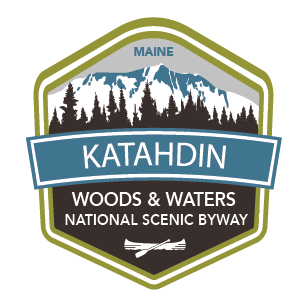A Brief History of the Area
The legendary and archeological history of Indian occupation of and travel through this land tells of thousands of years of seasonal migrations along great river highways in birchbark canoes.
The first colonial settlers arrived in the mid-1770s, establishing frontier outposts along major rivers. Indian guides were hired to assist Euro-American explorers and surveyors. By the mid-19th century, the increase of lumber activity on the upper Penobscot River provided employment in exploration, timber harvesting, lumber camps and river driving, sport fishing and “rustication.”
Small scale lumbering from 1770 on was undertaken by families and limited partnerships. The seemingly endless forest was of enormous value to an expanding America. A thriving shipbuilding industry on the Maine coast flowed directly from the timber riches of the Katahdin area. The Great Northern Paper Company was established in 1900 with the building of a large mill in Millinocket, followed by a second mill in East Millinocket which was built in 1906. Farms in the region were established primarily to support lumbering operations. The building of Millinocket, the “Magic City,” was legendary in its own time, drawing spectators from all over to witness a new metropolis rising out of the wilderness.
Maine’s northern forest is the largest contiguous block of undeveloped forestland east of the Mississippi; this includes approximately 10.5 million acres of unorganized territory which remains largely forested and uninhabited. Maine’s forests have been harvested for wood products for over 200 years, yet 90% of the state remains forested—the highest percentage in the country.
Perhaps it was Henry David Thoreau and his chronicles of the Maine woods that best captured and then projected the character of the region, impressing readers around the world with wild and inspirational expanse. Assisted by Penobscot Indian guides, Thoreau made three major excursions through the region in the mid-19th century. His revered expeditionary journal offered a portrait of a robust industrial and agrarian economy emerging at that time on the doorstep of the wilderness.
By 1900 the region was already becoming famous as a vacation and resort destination. Overnight rail journeys brought adventurous people from major cities to rustic camps. Summering in Maine both on the coast and in the undeveloped Maine woods allowed escape from the heat, noise and crowds of the cities.
The creation of Baxter State Park began in 1930. Governor Percival Baxter, using his own wealth, piece by piece purchased more than 200,000 acres of land, including Mount Katahdin. He donated this invaluable property to the citizens of Maine with the proviso that the land would remain “forever wild.” The additional $7 million endowment Governor Baxter left to care for the park made it a truly unique gift. Baxter State Park offers dozens of mountain and back-country trails, campsites, picnic areas, streams, ponds, waterfalls and lakes for all to enjoy.
The Katahdin Woods & Waters National Monument includes 87,563 acres of mountains and forestland along both sides of the East Branch of the Penobscot River, east of Baxter State Park. It is a special part of Maine with world-class fishing, mountain biking, hiking, canoeing, hunting and a new cross country ski trail.
There may be no more compelling testimony to the breathtaking scenic quality of this Byway area than the artists of both national and international standing who have traveled to the Katahdin region. From Frederic Church to Marsden Hartley, Neil Welliver and Carl Sprinchorn, artists have returned time and again over two centuries and in all seasons to render the Katahdin range’s ever-changing and always highly dramatic views. The current paintings of this historic school can be viewed at several galleries along the Byway, clustered primarily in the Millinocket area.
The Katahdin Woods & Water National Scenic Byway
meanders for 89 miles–enjoy your adventure!


Welcome to the Katahdin Woods and Waters National Scenic Byway!
The Katahdin Woods & Waters National Scenic Byway is 89 miles long and offers breathtaking views of Katahdin and the Appalachian chain, and provides a mix of pastoral farms, meadows, recreational trails, and working forests filled with wildlife and significant natural areas. Dominating that landscape is Katahdin, Maine’s tallest mountain at 5,268 feet and the northern terminus of the Appalachian Trail. The Byway begins at the southern entrance of Baxter State Park and winds its way through Millinocket along Route 11 and the Penobscot River to Patten, ending at Baxter’s northern entrance at Grand Lake Matagamon. Select your adventure!




